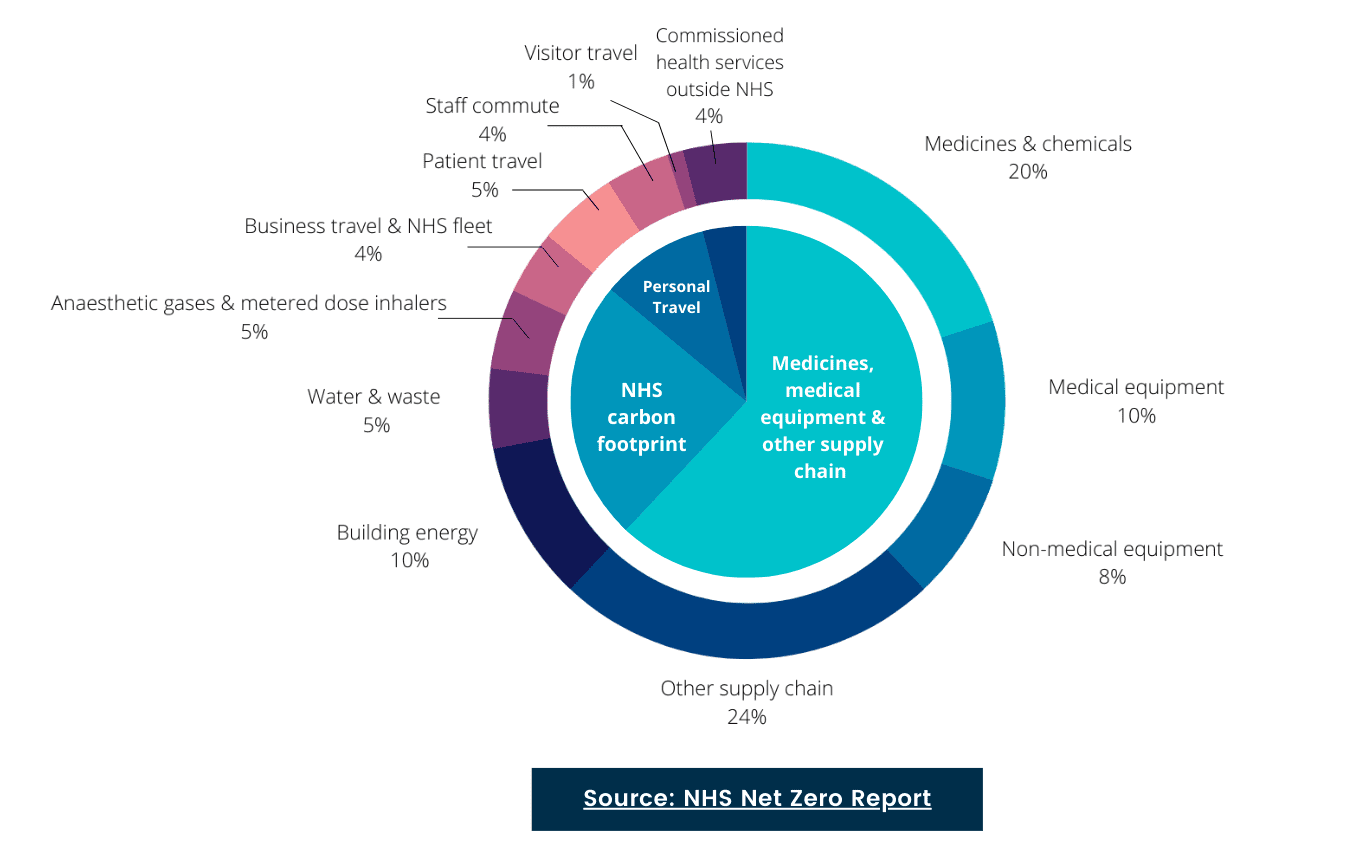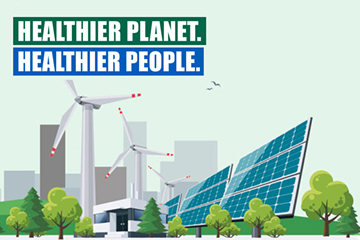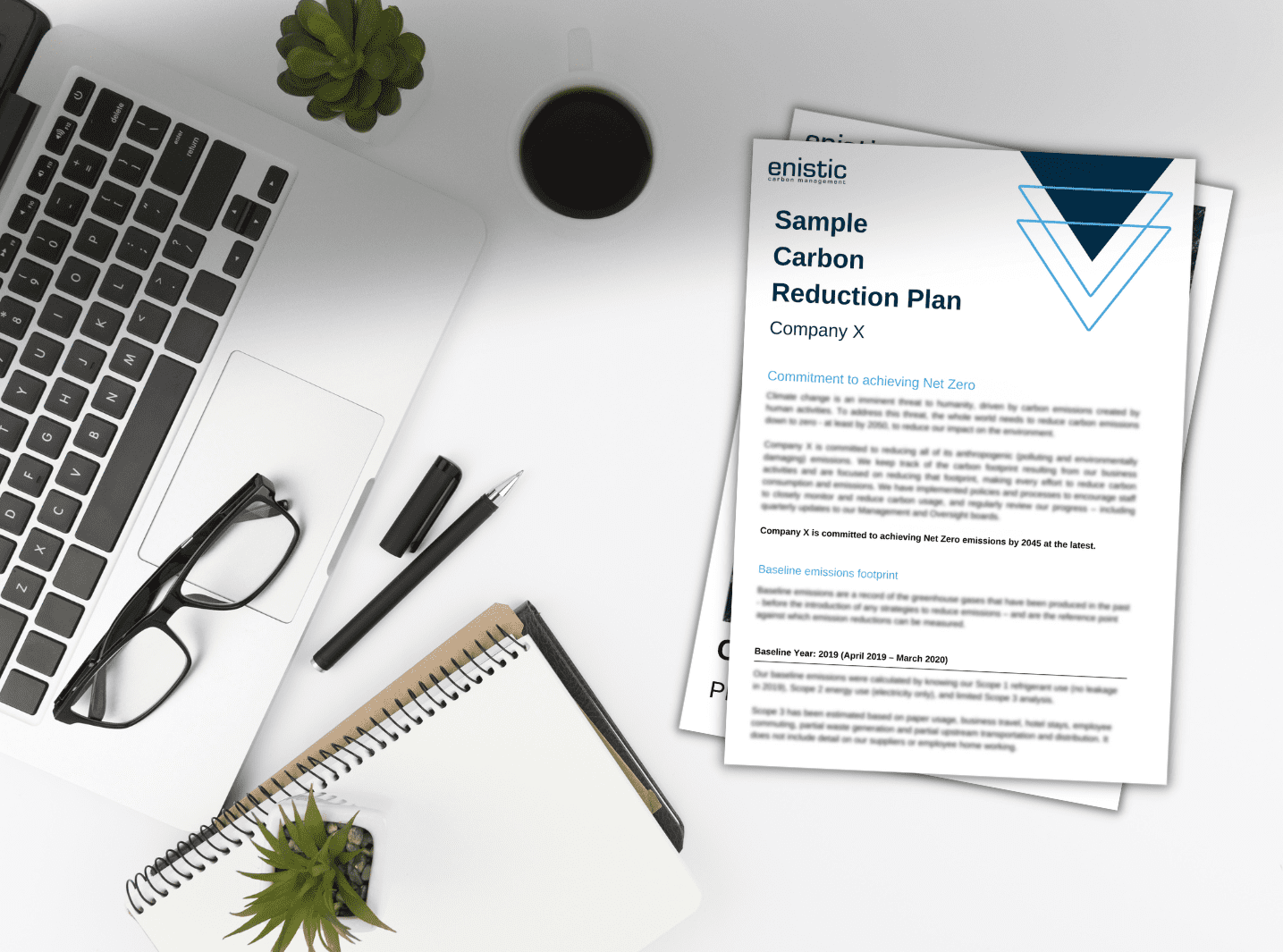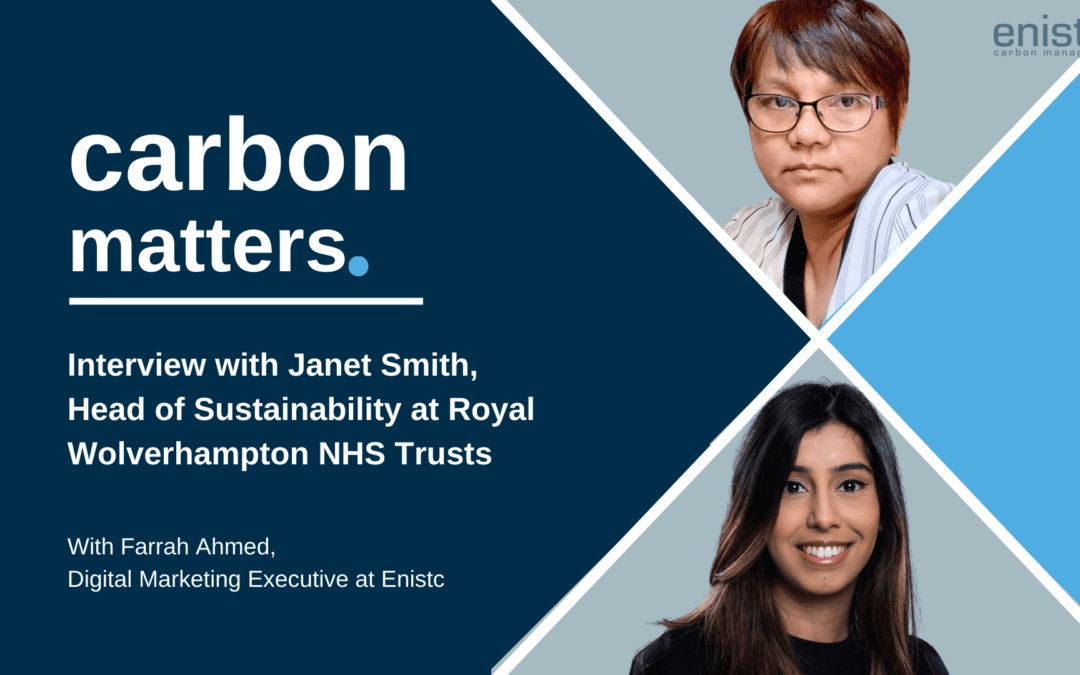Interview with Janet Smith, the Head of Sustainability for the Royal Wolverhampton Trusts
Watch the full interview here: https://www.youtube.com/watch?v=myyTYsH74f8
So the trust is one of many involved in the Greener NHS programme in which the NHS has set the target of becoming the world’s first nNet Zero National Health Service. So for the emissions that they control, the target to reach Net Zero is 2040. And for the emissions that are out of their control, it’s 2045.
So Janet, would you mind telling us a little bit about your role at Royal Wolverhampton trusts?
Yes, my role is the Head of Sustainability and the main part of my role is to ensure that the Trusts Green Plan is implemented. So it’s actually looking at facilitating the initiatives that each of our services comes up with, and ensuring that they get the proper support that they require, whether it is internally, from different departments within the trust or externally, from our partner organisations.

So to kick off, what are your thoughts on the Greener NHS Programme and the targets that they’ve set?
I think it’s about time really for the NHS to address climate change and to address its carbon footprint, because, as you know, the NHS produces over 4% of the country’s carbon footprint and its impact actually really affects the health of the communities that we work with.
And also as a trust, we will also be addressing health issues as a consequence of the climate change impact, such as increased asthma cases for children, things that also affects our women in terms of their maternity services, etc.
So in 2019, the Trust’s carbon footprint was just over 19,000 tonnes of CO2 emissions. What kind of figure is the trust looking at now?
Well, at the moment, it’s about three times that – a traditional way of looking at it relates to buildings, so your estate, your energy, your gas consumption. So those are the traditional sources of carbon emissions that we looked at.
The 19,000 tonnes of carbon that we established in the Green Plan actually relates to Scope 1 and Scope 2. We are actually now looking at an increase of that.
Our Scope 3 carbon emissions actually made up about 72% of our carbon footprint. We determined after a carbon footprinting exercise that our supply chain makes up 32% of the carbon footprint at the moment and that’s where the challenge actually lies.

It looks like each Trust has their own version of a Green Plan, which details their commitment to achieving net zero. What would you say have been the most successful sustainable measures that have been implemented at Wolverhampton trust so far?
At the moment, we are addressing the carbon footprint of each of the services. So let’s say for our clinical service, what they have done is look at how they deliver their service – the patient pathway, how they use their buildings, and also how they carry out or deliver the administration service. They look at the carbon footprint in a holistic manner. So what they realised by looking at their patient pathway was that actually they could reduce it quite a lot.
So they’ve managed to reduce their carbon footprint by over 18,000 miles, which is equivalent to about six times around the world. So in total, they have reduced over 78,000 miles a year on their logistics by reducing the frequency of their deliveries. That’s how much they reduced it by just looking at their internal processes.
They have also gone paperless with referrals with our award booklets and things like that. So by doing that they have reduced a lot of their carbon. We’ve also managed to reduce our use of volatile anaesthetic gases – one gas from 13.9 to 3.1, which is below the target than the NHS national set.
I can say that we are actually on course to hitting our 2025 target of reducing our Carbon Footprint by 25%. One area that we have made quite a difference in is our energy use since our sources are now actually renewables.

And considering how much pressure that the NHS is constantly under, do you believe that it’s imperative for the healthcare sector to be prioritising sustainability right now?
There are a lot of things that you can do to reduce your carbon footprint by looking at existing processes, and making them more efficient and effective. The initiatives used to reduce your footprint don’t actually have to cost a thing and don’t always require investment from the Trust itself.
The patient moving and handling team saved 1.8 tonnes of carbon, as well as delivering cost improvement of £1,500 by switching our patient slides into more sustainable ones, made up of recycled drinks bottles. So it might be small. But like I said, when you bring all of these little things together, then they become bigger.
So NHS suppliers are also being encouraged to align their sustainability targets with the NHS Net Zero trajectory. Has the trust implemented the Evergreen supplier assessment in any way? Do you kind of assess whether a supplier is sustainable before working with them?
At the moment, we are implementing PPN 06/21, this has become mandatory and actually where the Evergreen supplier scheme comes in. So we are following the supply chain roadmap to reach net zero, working with suppliers as well.
I’m following the Evergreen scheme because it’s the only scheme at the moment that allows suppliers to engage with the NHS. So we do work very closely with NHS supply chain.
Not all suppliers are at the same level, a bigger supplier might say, yes, okay, we can comply with all of the parameters set out by the NHS supply chain to actually participate in any of the future procurement exercises. But social enterprises, small and medium sized businesses don’t necessarily have the capacity yet. So that’s why we work with our local companies and the national supply chain to ensure that we’re not actually making it difficult for suppliers, ensuring that they’re not locked out from the procurement exercise that we’re currently doing.

What is PPN 06/21?
The Procurement Policy Note (PPN 06/21) was released by Crown Commercial Service in June 2021 and sets out how government departments need to take account of suppliers’ Net Zero Carbon Reduction Plans (CRP) in the procurement of major government contracts. It is subject to the Public Contracts Regulations 2015.
Since 30th September 2021, all NHS suppliers who bid for large government contracts (over £5 Million) have to comply with PPN 06/21, detailing their commitment to achieving Net Zero by 2045 and how they will reach the target.
Download the guide for NHS suppliers for details on PPN 06/21, CRPs and compliance requirements.

What is a CRP?
CRPs are to be completed on behalf of NHS suppliers and must meet the reporting requirements, as well as include the supplier’s current Carbon Footprint and its commitment to reducing emissions to achieve Net Zero emissions by 2045.
CRPs will help suppliers and the NHS understand what impact their wider operations have upon the environment. They detail the organisation’s emissions across a single year against a range of emissions sources and greenhouse gases.
Carbon Reduction Plans must be provided by suppliers when responding to in-scope procurements as defined by PPN 06/21. The Carbon Reduction Plan is not intended to replace existing reporting or calculation of your organisational Carbon Footprint. It is a summary document that details high level information that demonstrates your compliance with the measure.
The NHS has adopted the standard for their suppliers, however there are a few differences from the general reporting requirements and the way that they expect suppliers to adhere to it.
Download the Sample Carbon Reduction Plan to make sure you’re on the right track.

So do you think that the public actually understands and is even aware of the importance of sustainability and the effects that it has on healthcare?
There is awareness, but I don’t think there is really an in-depth understanding from the public about the effects of the health service and the procedures that they undergo in the hospital.
It is also imperative for us to actually educate the public on the carbon footprint that each of the services carries, when a person actually visits a hospital that has a carbon footprint by the number of months that the patient travels. So it’s about looking at educating the public about alternative ways of delivering that service.
I absolutely agree with you. I don’t think it’s that people don’t care. It’s just that the awareness is missing. And that’s where educating the public comes in, letting them know better ways to do things. So I’d also like to just ask you a little bit about the reporting process at the trust. So being such a large trust with surely a lot of data, how has the trust gone about reporting the data in order to understand their carbon footprint?
We have done a carbon footprinting exercise, so we know what the carbon footprint is on each of the areas that we need to report on. So energy, gas, anaesthetic gases and pharmaceuticals. We have what we call the ‘Sustainability Initiative Tracker.’ We also use the standard GHG Protocol.
What would you say has been the most challenging aspect of the reporting process?
It is actually when you come into scope 3. At the moment the reporting is actually based on the spend. So if you spend a pound, the current way of calculating it is you assign a conversion factor to it, but it’s based on spend rather than based on the carbon. It doesn’t take into account what the embodied carbon of the product is.
But I do understand that at the moment, the market is not mature enough for suppliers to actually provide us with the embodied carbon of their product or the logistic carbon of their product. So unless that side of things is actually mature enough to give us that specific information, then our reporting in terms of the carbon or the supply chain will be based on spend.
Staff and patient commuting has always been one of the difficult areas to look at. But we are implementing reduction initiatives. So we’re working with local transport companies like National Express, to provide discounted travel cards to patients to encourage them to choose sustainable modes of transport like buses, trains, cycling or walking. We’ve had relative success on our cycle to work scheme, with over 400 staff signed into it.

I think it’s fantastic that the trust is actually putting these kinds of things in place. Like with the travel partnerships, it’s an incentive for patients and for staff to get involved and reduce their emissions.
So my last question, do you have any tips or tricks for other sustainability teams in healthcare regarding the reporting process?
Based on our experience, you need to look at what you have as a baseline in terms of your carbon footprint. Without an idea of what your carbon footprint is, it’s really difficult to target initiatives, because it’s like basically shooting an arrow in the dark and hoping something gets hit by it.
So by knowing what your carbon footprint is, targeting initiatives to reduce the carbon footprint, and having a simple way of tracking that, then that’s what makes the difference. It doesn’t have to be complicated, because the more you complicate it, the more it becomes a burden to those that need to track it. It’s about small, simple things that when you bring it together, creates a bigger impact.
So that concludes our interview. Thank you so much Janet for giving us some insight into what Royal Wolverhampton trusts are doing in order to reach their net zero goals. It’s also been a really great opportunity to spread some awareness about the importance of sustainability as well as the challenges that can arise from carbon reporting.
Janet, I just like to offer you a few closing thoughts on sustainability in the healthcare sector wrapping up by saying, if you could ask people watching or listening to do one thing that could help, what would it be?
It would be taking action as an individual, as a part of a team and as an organisation. If we don’t take action, it’s an issue that will haunt us in the next decades. So that’s just my last words, to encourage everyone to take action now, so that we can make a difference in the future.
How can we help?
To achieve Net Zero you will need to do a lot of calculations. Calculating your Carbon Footprint and monitoring it is one of the most important things you’ll need to do, as it will help you understand where you stand, and it will set a starting point for your Net Zero journey.
That is why it is really important to be accurate with the data collection. Moreover, climate change data is as important as financial data, so it will need to be complete, accurate and timely.
You can collect this data manually, through a consultancy or with a platform. Doing it manually is your lowest cost option, but this does also increase the chance of making mistakes or forgetting bits of your data. For many, using a platform is the best option in terms of cost-time balance. With the Enistic Platform, you are required to enter the data, with the software automatically checking if you are missing data or if it is not correct.
The Enistic Platform is the professional cloud-based software that allows you to calculate your Carbon Footprint and monitor it. It has a Carbon Planner integrated that will allow you to create a Carbon Reduction Plan and see the impact of your carbon reduction projects. Moreover, it gives you the opportunity to enhance your company’s energy and cost efficiency through advanced software with the help of our experts.

Book a free consultation
Contact one of our Net-Zero experts today and book a free consultation to see how Enistic can help you set your Net Zero strategy. We will make the processing time and cost-effective. ensuring you move forward, informed, empowered, and confident that you have control.




